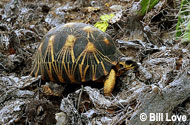Description:
The radiated tortoise has always been a heavily sought after tortoise because of its large size and stunning radiated pattern. It is sometimes classed as the largest of the star type tortoises. It is not overly common in the pet trade because it is listed as both an Endangered Species and as an Appendix I animal for international trade. Both of these listings make it very difficult to legally obtain a Radiated tortoise. The tortoise is rightfully protected by this listing because of its limited range and its high desirability in the pet trade although it is reported to be fairly common in the range in which it occurs. Radiateds are becoming more common in collections due to very successful breeding in captivity regardless of the heavy restrictions in permitting in the United States. In Europe and Asia it is even more common although the legality of many of these animals is often questioned. Radiated tortoises are not only attractive, but in captivity they have a unique personality in that they are very passive in addition to being outgoing frequently looking for the attention of the keeper. These tortoises adapt well to captivity when kept within a temperature range of 75 to 100 degrees Fahrenheit with a basking spot at the warm end of the range. Radiateds are not very cold tolerant. They are opportunistic feeders consuming mostly dark leafy greens, fibrous fruits such as apples and pears in addition to various berries. They are also known to consume carrion. A water dish with clean fresh water should be provided at all times.
Habitat:
Coastal scrub land.
Range:
Southwestern Madagascar.
Scientific Name: Geochelone (Astrochelys) radiata
Species Group: tortoise
Family: Testudinidae
Size: 15 to 40 lbs
Level: intermediate
Weight: N/A
Dangerous: No


